These Pictures Will Help You Identify the Most Common Skin Rashes
"Hearst Magazines and Yahoo may earn commission or revenue on some items through these links."
In our quest to maintain healthy skin, a few bumps in the road (or on our complexion) are inevitable. And while nobody likes to deal with bumpy, red, or itchy skin—rashes happen. Combing through pictures of skin rashes can help identify exactly what you’re dealing with and help you determine the best treatment.
“A rash is essentially inflammation in the skin that can be caused by either an external exposure or an internal factor,” says Joshua Zeichner, M.D., director of cosmetic and clinical research in dermatology at Mount Sinai Hospital in New York City. Basically, a rash is your skin’s way of telling you something is up, whether you’ve been exposed to an irritant or you have an underlying medical condition.
Meet the experts: Joshua Zeichner, M.D., director of cosmetic and clinical research in dermatology at Mount Sinai Hospital in New York City, Karan Lal, D.O., M.S., F.A.A.D., double board-certified adult, pediatric, and cosmetic dermatologist with Affiliated Dermatology in Scottsdale, AZ
The unifying feature of all rashes is inflammation, Dr. Zeichner explains. That inflammation could be minor or could greatly impact the color, texture, or feeling of your skin—it all depends on the type and severity of your rash. (Note: Some of the chronic skin conditions listed below, like acne and rosacea, might not be considered rashes by all dermatologists, but their symptoms and treatments are similar enough to other rashes to include them in this list.)
What causes skin rashes?
When it comes to the root causes of rashes, they tend to fall into two main categories: outside-in and inside-out, explains Dr. Zeichner. A few distinct features make their identification and treatment unique.
Outside-in rashes, like contact dermatitis and ringworm, are due to direct exposure to an outside irritant, allergen, or organism. Irritants (substances like household cleaners and chemicals that can affect anyone) and allergens (substances like latex and poison ivy that only affect those with specific allergies) can both trigger rashes such as contact dermatitis. Meanwhile, organisms living on the skin can cause conditions like ringworm and scabies.
Inside-out rashes stem from genetics, allergies, or infections. Genetic rashes, like eczema or psoriasis, appear because your skin or immune system is triggered to produce them. Allergic rashes, like a drug rash, occur when you ingest an allergen, including certain foods, such as peanut allergies, or medications. And viral infections, like coronavirus, can also result in rashes.
Many of these rashes can be resolved with proper treatment, except in the case of inside-out rashes caused by genetics. “Our bodies are genetically programmed to work a certain way, and while we can keep symptoms under control, we don’t necessarily have a permanent cure,” Dr. Zeichner explains.
Ahead, you’ll find pictures of common skin rashes, plus symptoms to look out for. It’s important to note that rashes can look different depending on your skin tone. Some conditions might not cause discoloration on darker skin so if you’re unsure, see a dermatologist who can make the proper diagnosis.
Eczema
What it looks like: Medically known as atopic dermatitis, eczema is an umbrella term for a range of skin conditions characterized by red, splotchy, dry, cracked, crusty, or flaky skin, that can emit clear fluid when scratched. It’s usually clustered around the insides of elbows and knees, but can appear anywhere on the skin.
Other symptoms to note: Eczema is usually itchy and most common in young people, although many adults also have eczema-prone skin. An estimated 30% of Americans, mostly children and adolescents, suffer from eczema, per the National Institutes of Health. Cold, dry weather and overexposure to water can exacerbate the condition, according to Dr. Zeichner.
Treatment: There is a range of potential treatment options for eczema, and the right one for you ultimately depends on how severe your eczema is. Moisturizer is recommended for everyone with eczema, according to the American Academy of Dermatology (AAD). (Here are some of the best eczema lotions.) However, more severe eczema may require creams and ointments like corticosteroids to get the rash under control.
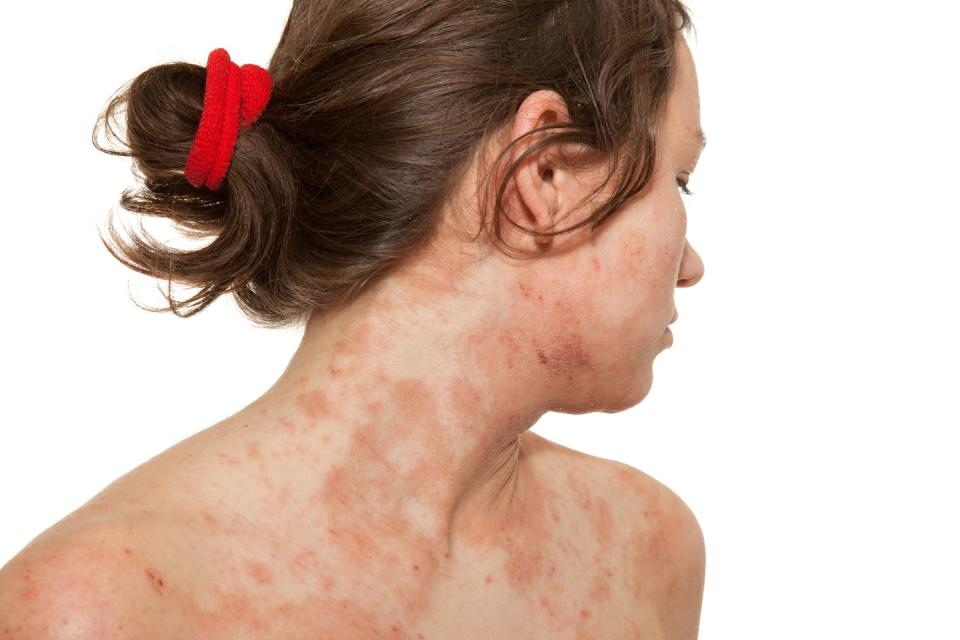
Contact dermatitis
What it looks like: Contact dermatitis has the same symptoms mentioned above, and can be a red rash that appears scaly or blistered, depending on its cause and severity. This rash often has a distinct border.
Other symptoms to note: Contact dermatitis appears following exposure to an irritant or allergen, and it’s the most common rash caused by external factors, Dr. Zeichner says. (This can include certain chemicals, acids, botanicals, metals, and more.) Allergens usually cause a shiny, blistered, itchy rash, while irritants tend to cause a dry, scaly, less itchy rash. It can appear hours to days after exposure.
Treatment: Treating contact dermatitis usually involves applying steroid creams or ointments to your skin, Dr. Zeichner says. In more severe cases, your doctor may prescribe you pills to help reduce swelling, relieve itching, or fight a bacteria infection.
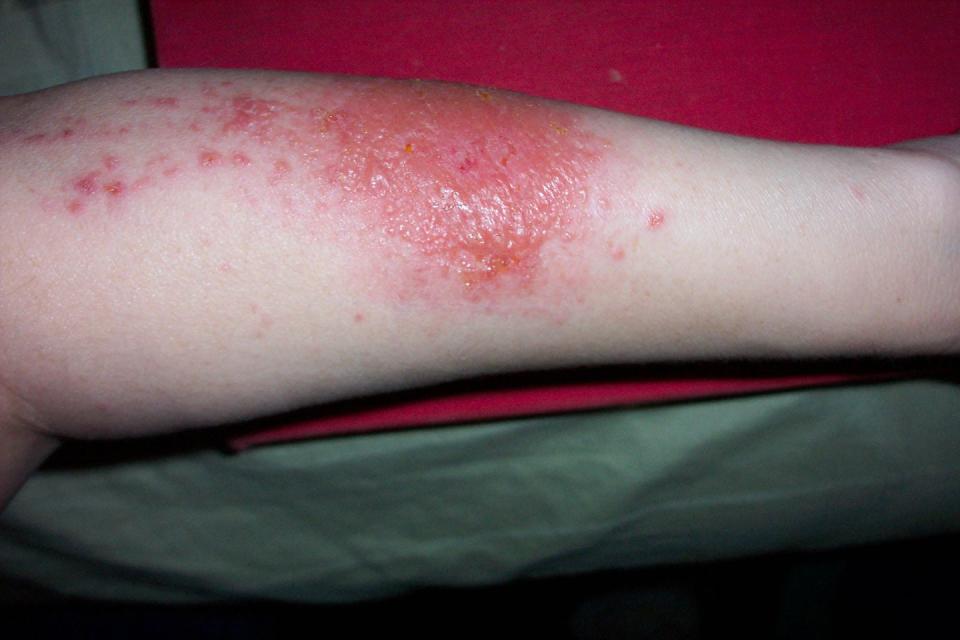
Poison ivy
What it looks like: Poison ivy is a type of allergic contact dermatitis that is caused by the oil (urushiol oil) in the poison ivy plant, explains Karan Lal, D.O., M.S., F.A.A.D., double board-certified adult, pediatric, and cosmetic dermatologist with Affiliated Dermatology in Scottsdale, AZ. This rash presents with red, hive-looking plaques that are very itchy. You may also see black dots on your skin from the oil that has oxidized on the skin.
Other symptoms to note: A poison ivy rash is extremely itchy and is often accompanied by swelling and blisters, Dr. Lal says. Sometimes these blisters are linear in appearance. If exposed to poison ivy, be sure to rinse the area in water only as soap can further spread the oil from the plant. Treating a poison ivy rash usually involves prescription-strength topical or even oral steroids that will usually clear the rash in about seven to 10 days, explains Dr. Lal.
Treatment: You can relieve the itch by applying cool, wet compresses to the rash and layering on an over-the-counter corticosteroid cream, according to the Food and Drug Administration (FDA). OTC skin protectants like zinc acetate, zinc carbonate, zinc oxide, and calamine can also help dry the oozing and weeping, while baking soda or colloidal oatmeal may help with the itch, the FDA says.
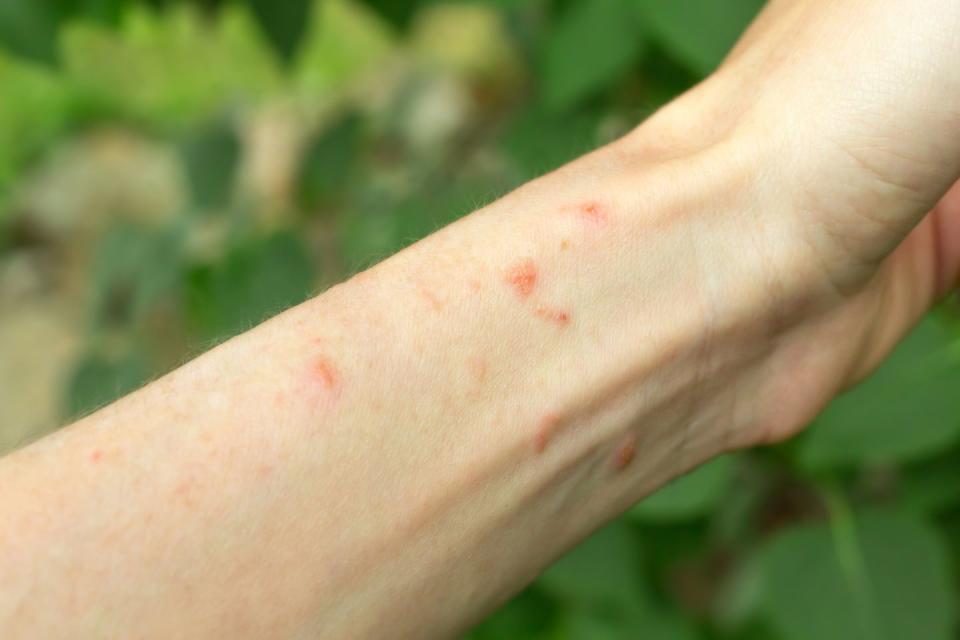
Ringworm
What it looks like: Ringworm is a common skin infection caused by a fungus. It gets its name from its circular rash, which is often red, swollen, and cracked.
Other symptoms to note: This rash is itchy and can cause hair loss when it occurs on the scalp. The same fungus also can cause athlete’s foot and jock itch. Ringworm is contagious, so avoid touching people and pets or sharing objects like towels with others during flareups.
Treatment: Ringworm can usually be treated with antifungal creams, lotions, or powders applied to the skin for two to four weeks, according to the Centers for Disease Control and Prevention (CDC). If that doesn't help, you may need prescription medication.
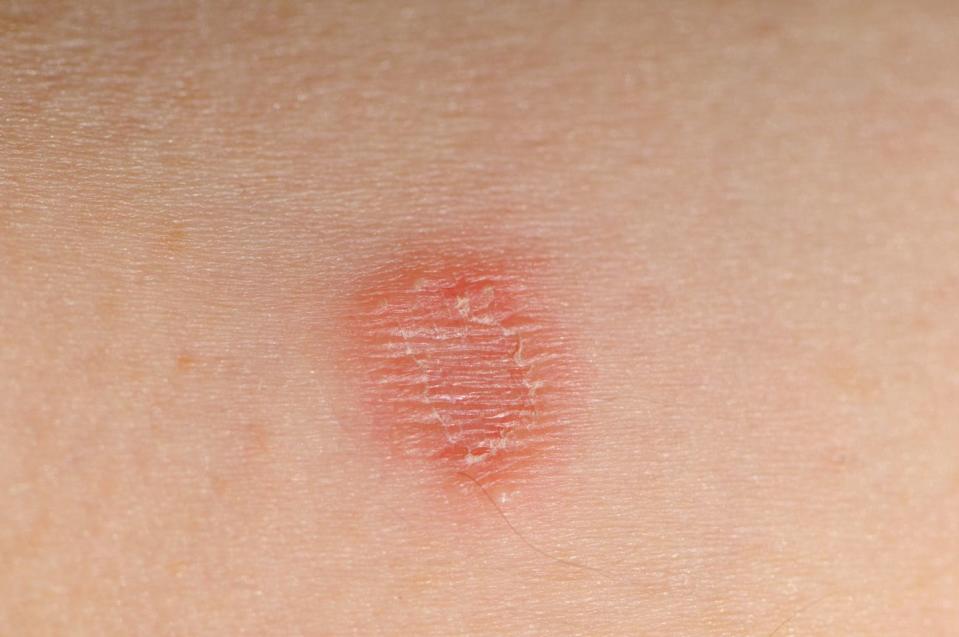
Rosacea
What it looks like: Rosacea causes redness and thick skin on the face, usually clustered in the center. Easy flushing, a stinging sensation, and small, pus-filled pimples are other common signs of the condition, which is often confused with acne breakouts.
Other symptoms to note: With rosacea, skin might feel rough, bumpy, or warm to the touch. Redness usually appears on the forehead, nose, cheeks, and chin. Red, itchy, sensitive eyes are also associated with the condition. Triggers include “spicy food, hot beverages, alcohol, extremes in temperature, and physical and emotional stress,” Dr. Zeichner explains.
Treatment: Rosacea is usually treated with gentler skincare products, as well as a treatment called intense pulsed light therapy to tamp down on redness, the AAD says. Brimonidine gel or oxymetazoline cream, and laser therapy may also help with persistent redness. Here are some more rosacea treatments for flare-ups.
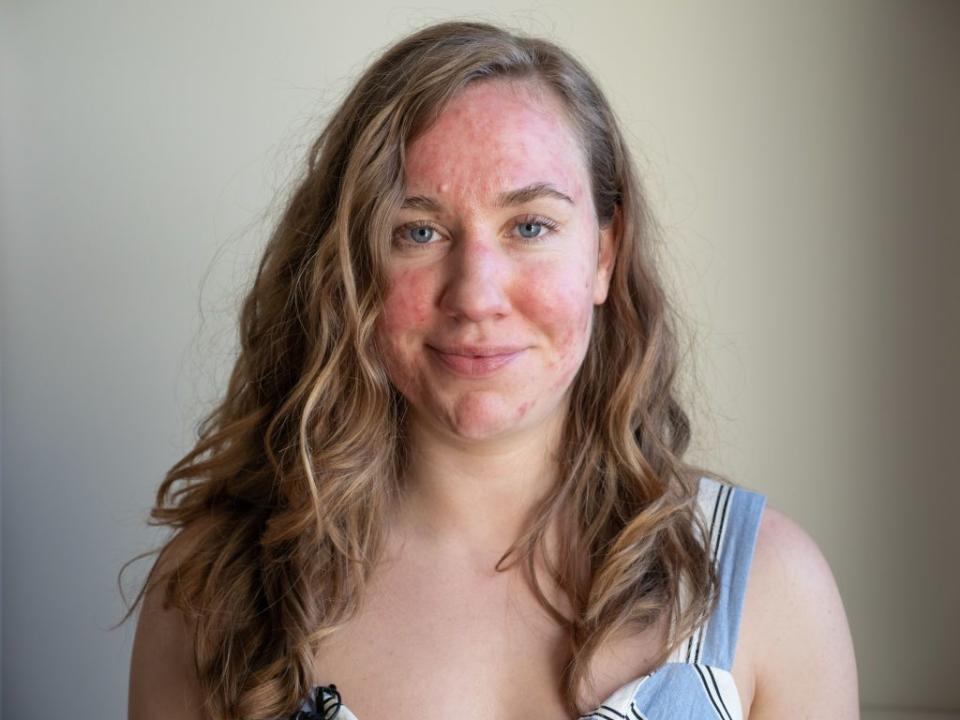
Psoriasis
What it looks like: Psoriasis causes patches of thickened skin, most often with silver, scaly flakes. It’s usually found around the elbows, feet, knees, palms, and you can even have scalp psoriasis.
Other symptoms to note: Telltale scales set psoriasis apart from other rashes. Per the CDC, up to 20% of people with psoriasis also experience psoriatic arthritis. Psoriasis is not contagious; it’s due to “overactivity of the immune system resulting in skin inflammation,” Dr. Zeichner explains.
Treatment: Treatments can include corticosteroids, vitamin D analogues, retinoids, and coal tar, Dr. Zeichner says. Ultimately, it's best to consult a dermatologist to find the best treatment plan for you.
Right image credit: Tim Kubacki
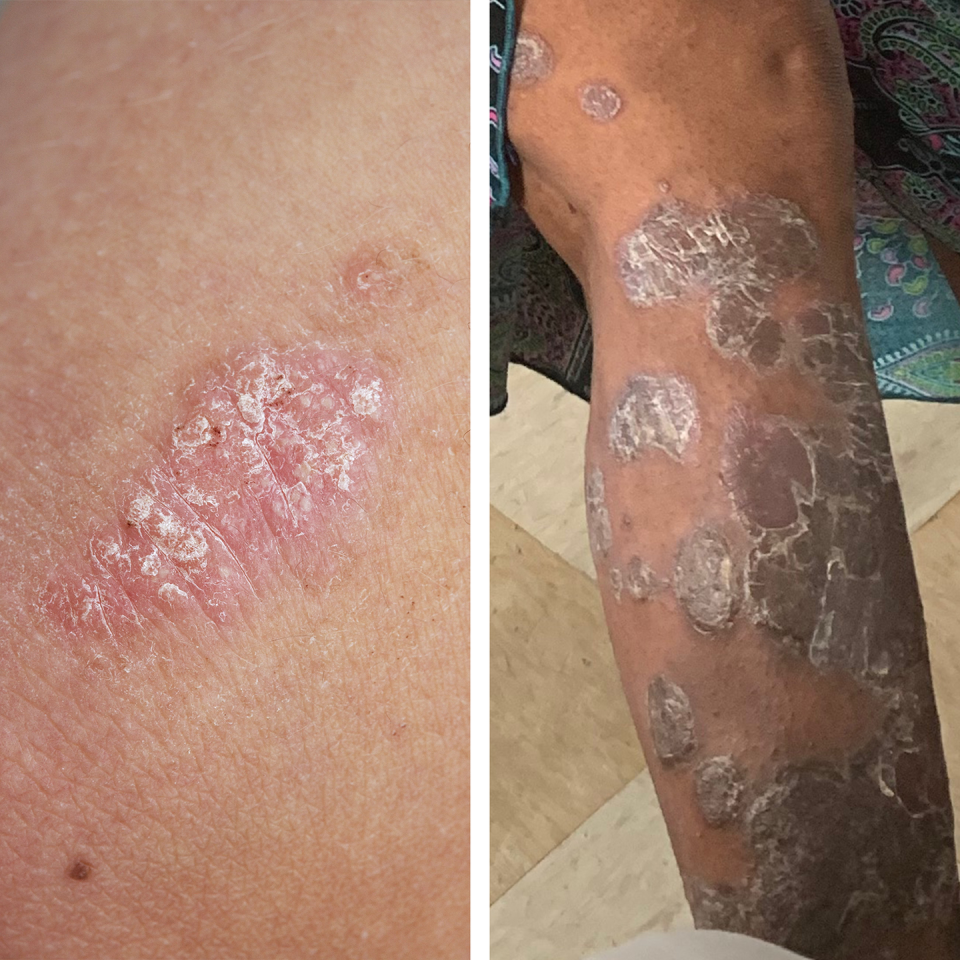
Hives
What it looks like: Also called urticaria, hives are raised welts in the skin that appear red or discolored. They range in size from small bumps to larger patches.
Other symptoms to note: Hives are most of often the result of exposure to allergens, and they could be a sign of a serious allergic reaction. Hives might not cause any discoloration on darker skin, so be alert for raised patches or welts—those could be a sign of urticaria. If you have shortness of breath, throat tightening, or tongue swelling, you should seek medical help right away.
Treatment: The standard treatment for hives is antihistamines, which are available in OTC and prescription forms, the Mayo Clinic says.
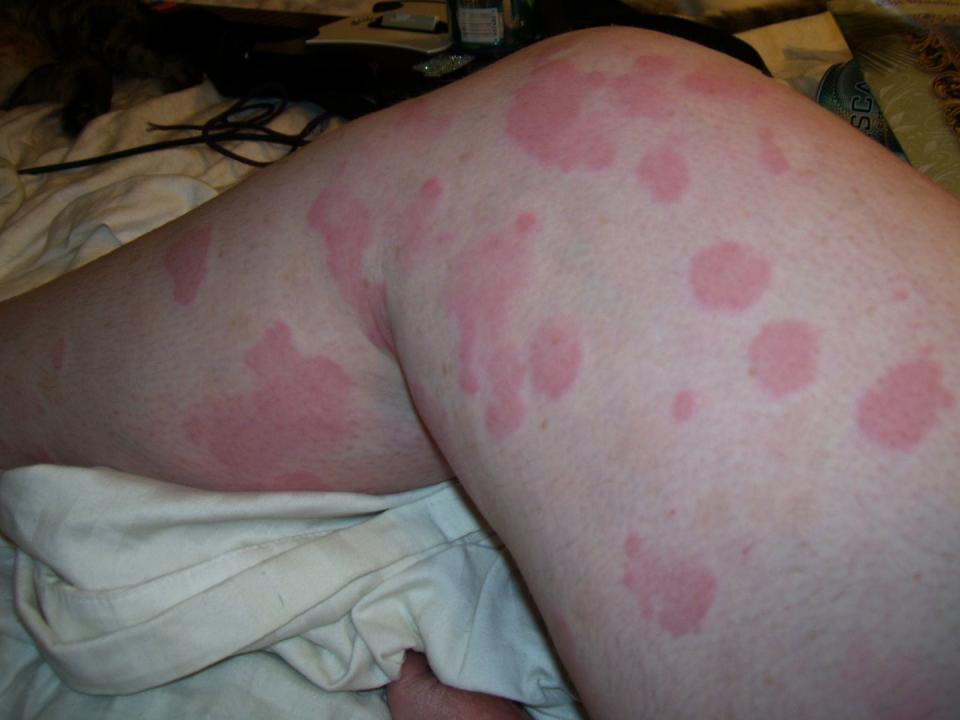
Acne
What it looks like: Acne causes red, discolored bumps on the skin, along with whiteheads, blackheads, and cysts.
Other symptoms to note: Acne is the most common skin condition affecting Americans, Dr. Zeichner says, so you likely have experience with pimples already. The causes vary, but are often rooted in excess oil and bacteria on the face, chest, or back, which can be triggered by hormonal issues, stress, certain foods, and irritating products.
Treatment: The right treatment for acne usually depends on the type of acne you're facing. However, the AAD says that cleaning your skin properly and keeping your hands off your face can help. If you have acne, it's best to visit a dermatologist for personalized tips, Dr. Zeichner says. Here are some adult acne treatment options.

Chicken pox
What it looks like: “Chicken pox is rare [outside of childhood], but we still see it,” Dr. Lal explains. It appears as marks that resemble “dew drops on a rose petal” or like blisters on a red bump, according to Dr. Lal. Sometimes you will see red bumps at first that then progress into blisters, but overall when you see chickenpox, you’ll see various stages of healing where some older areas are crusty and dry while newer areas will be more red, bumpy, and itchy.
Other symptoms to note: Chicken pox rashes typically start toward the middle of the body and work outward toward the extremities. It can often cause pockmarked scars after the blisters heal. Additionally, if an individual is unvaccinated when they contract chicken pox it can be very dangerous and cause pneumonia or other severe illness, according to Dr. Lal.
Treatment: There are a few things you can do at home to help relieve the itch, the CDC says. That includes using calamine lotion and a cool bath with added baking soda, uncooked oatmeal, or colloidal oatmeal. Also, try to keep your fingernails trimmed short and minimize scratching to prevent the virus from spreading and to prevent skin infections.
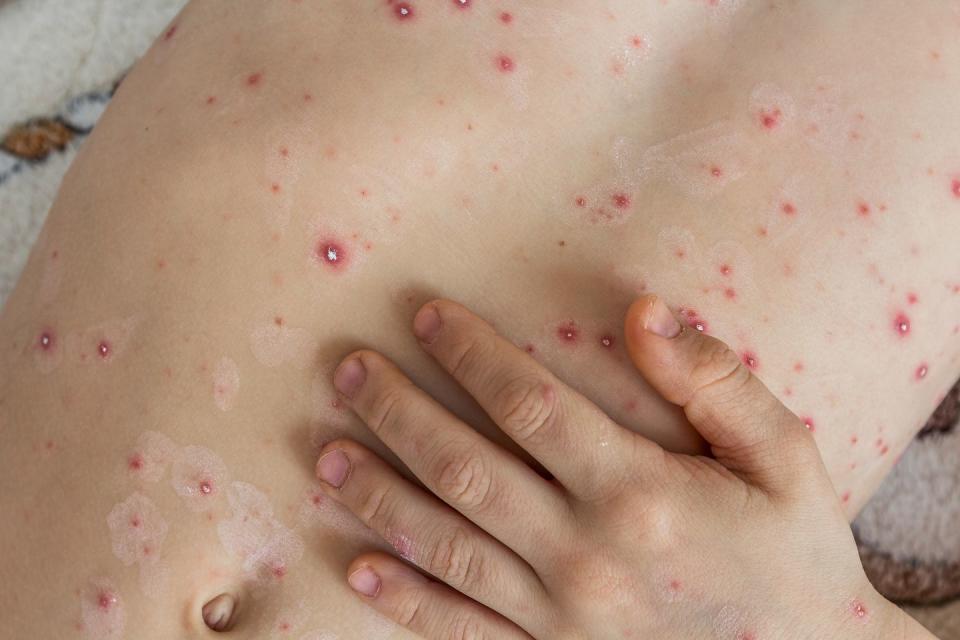
Shingles
What it looks like: Also known as herpes zoster, shingles is a blistering rash. It often appears in a stripe or in the top quadrant of the head, but only on one side of the body.
Other symptoms to note: Blisters are painful and are sometimes accompanied by fever, headache, and chills. Local tingling or pain is common before the blisters appear. Shingles can affect the eye and even cause vision loss. The condition is caused by the same virus as chickenpox. Also, if you’ve been infected with COVID-19, you may be at a higher risk for shingles.
Treatment: There are several antiviral medications to treat shingles, including acyclovir, valacyclovir, and famciclovir, the CDC says. Cool compresses, oatmeal baths, and calamine lotion may also help.
Bottom image credit: Preston Hunt

Seborrheic dermatitis
What it looks like: Seborrheic dermatitis is a form of eczema that is characterized by scaly, oily or greasy patches of skin, usually on the scalp.
Other symptoms to note: This condition is itchy and can cause dandruff and buildup on the scalp. It’s also common on other oily areas, like the face and chest, and can be difficult to treat. Dr. Zeichner explains that although the exact cause of seborrheic dermatitis is unknown, the body overreacts to yeast on oily parts of the skin, causing the thick, flaky buildup.
Treatment: To treat seborrheic dermatitis, use one of these best of the best dandruff shampoos.
Top image credit: Amras666

Perioral dermatitis
What it looks like: Like seborrheic dermatitis, perioral dermatitis causes red, inflamed skin and small pustules around the nose and mouth.
Other symptoms to note: Flare-ups can be itchy and uncomfortable, and are often confused with acne. There is no known cause of perioral dermatitis, but overuse of topical corticosteroids is associated with the condition.
Treatment: If you develop this condition, it's best to stop using all face creams, cosmetics, and sunscreen, and to wash your face with warm water only, Mount Sinai says. Your doctor may recommend a range of medications, including metronidazole, erythromycin, and benzoyl peroxide.
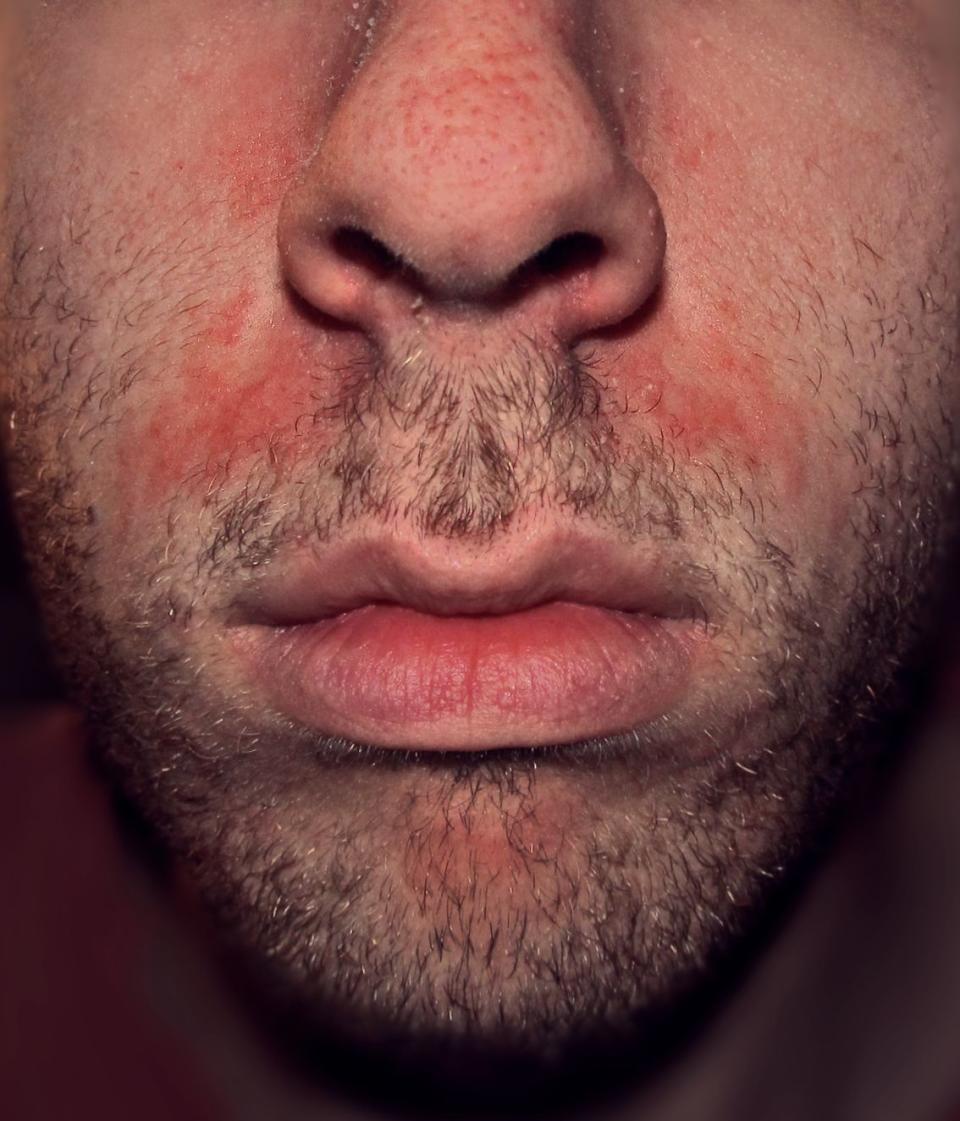
Scabies
What it looks like: Scabies is a discolored, splotchy rash that can appear pimple-like on any affected parts of the skin. Patients might also notice tiny lines on the skin where the mites have burrowed.
Other symptoms to note: Scabies is very itchy, and usually more intense at night. Unlike the other rashes on this list, this one is caused by an infestation of mites. It’s very contagious and spreads easily through skin-to-skin contact in crowded spaces.
Treatment: Permethrin is the drug of choice for the treatment of scabies, the CDC says. Topical permethrin should be applied every two to three days for up to two weeks.
Top image credit: Cixia
Bottom image credit: Tim Kubacki
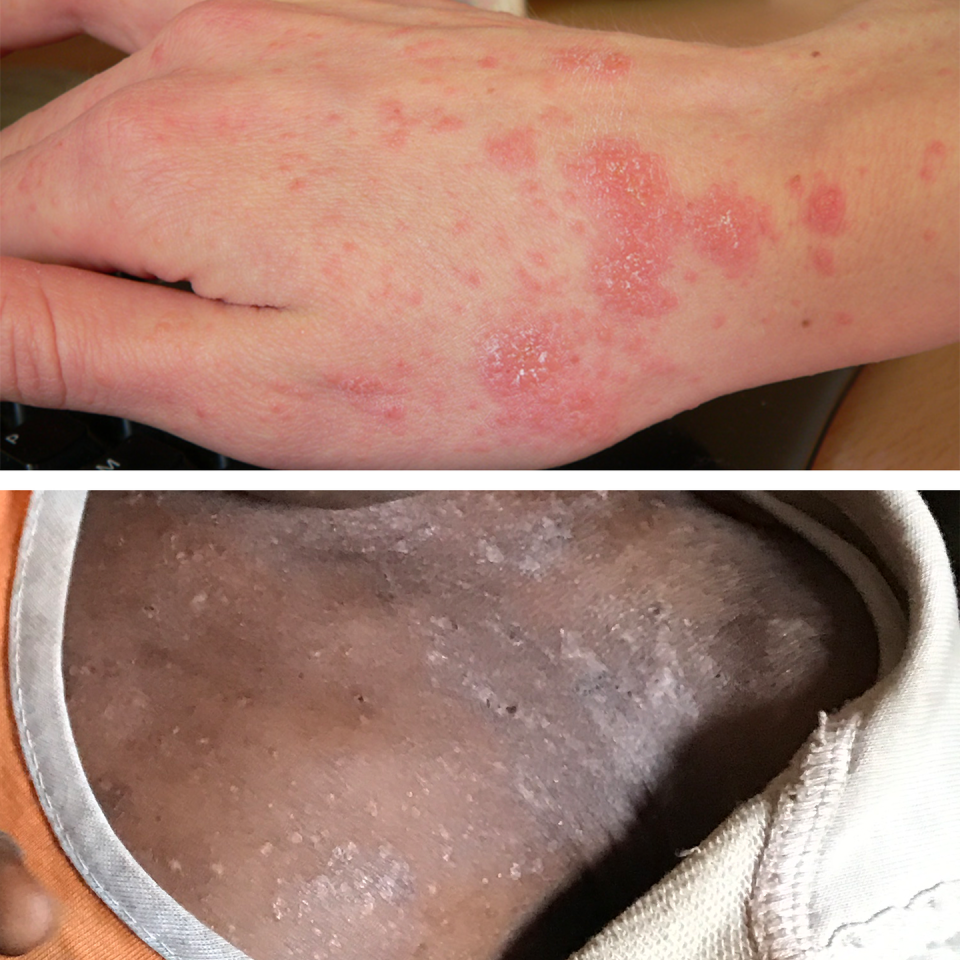
Drug rash
What it looks like: Drug rashes are usually speckled, itchy, and red, and can cover large areas of skin. They can appear days to weeks after taking medication.
Other symptoms to note: Drug rashes can be a side effect of or a reaction to a new medication; almost any medication can cause a drug rash, but antibiotics and NSAIDs are the most common culprits. The rash might not be anything to worry about, but it could be a sign of a serious allergic reaction, especially if combined with difficulty breathing.
Treatment: Contact your doctor immediately if you experience these symptoms. Typically, they will recommend that you stop taking the medication immediately, and they may prescribe an anti-inflammatory medication to help with the rash, Dr. Zeichner says.
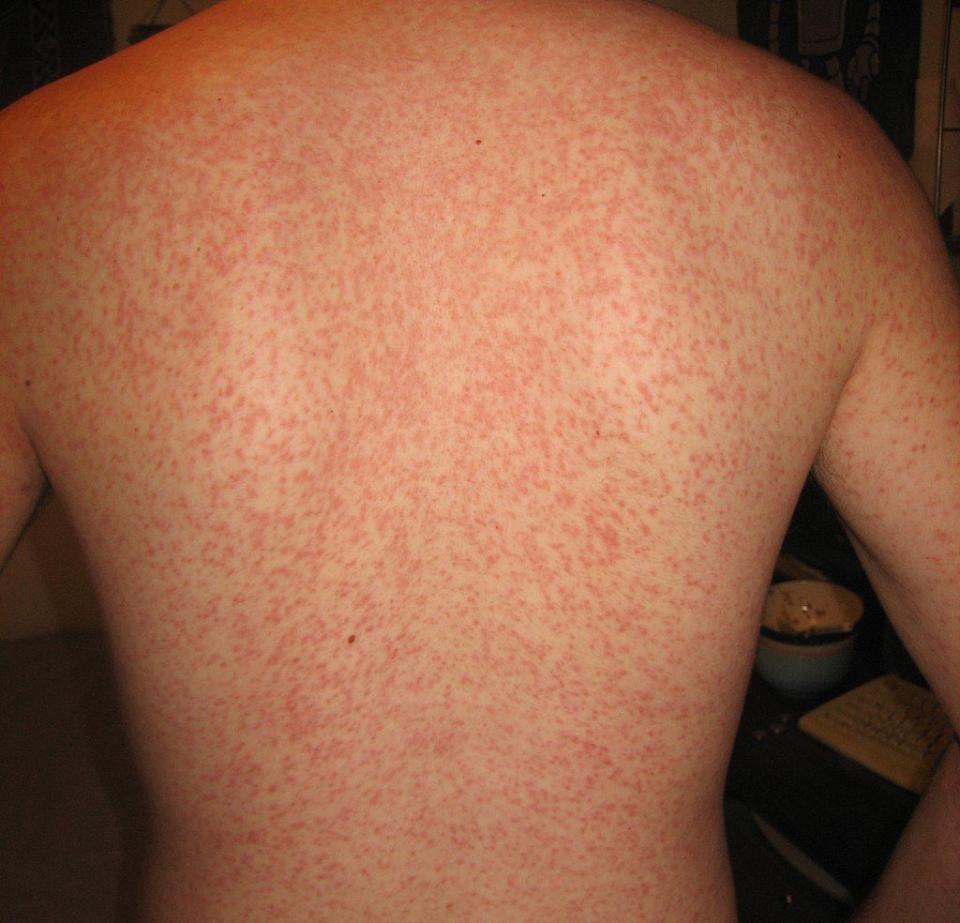
Candida
What it looks like: Candida, a type of yeast infection, can occur in lots of places—including the skin. It often occurs when the skin microbiome is dysregulated, causing an overgrowth of the yeast that normally lives on our skin, Dr. Lal explains. These rashes are often very red, macerated, and erosive-looking and are accompanied by red bumps or papules.
Other symptoms to note: Candida rashes often have a “sour, yeasty odor,” Dr. Lal explains. Additionally, these rashes are accompanied by a burning sensation rather than a typical itching sensation.
Treatment: If your doctor diagnoses your rash as a candida infection, treatment will likely involve a prescription antifungal medication. These medications are often topical, but oral treatment is available for more serious cases.
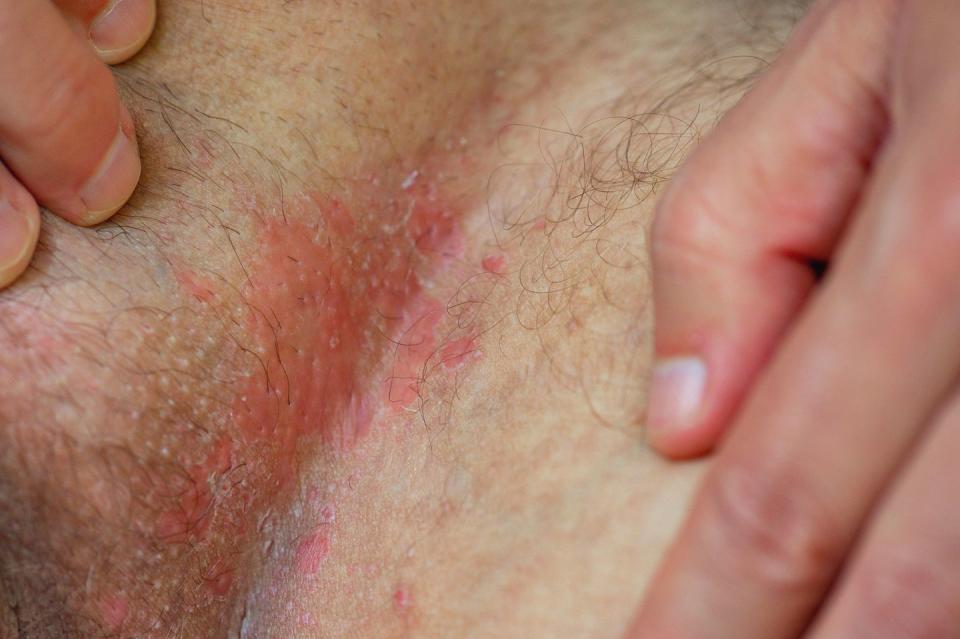
Lichen planus
What it looks like: Purplish lesions on the inner arms, legs, wrists, or ankles can signify lichen planus, a skin rash triggered by an overreaction of the immune system.
Other symptoms to note: The legions are usually itchy and may cause skin discoloration as they heal. Lichen planus does not have one single cause—illnesses, allergies, and stress can all trigger breakouts. It is not contagious.
Treatment: Lichen planus doesn't have a cure, but some treatments can make you feel more comfortable and speed up the healing process. Those include antihistamines and topical or oral steroids, John's Hopkins Medicine says.
Right image credit: James Heilman, M.D.
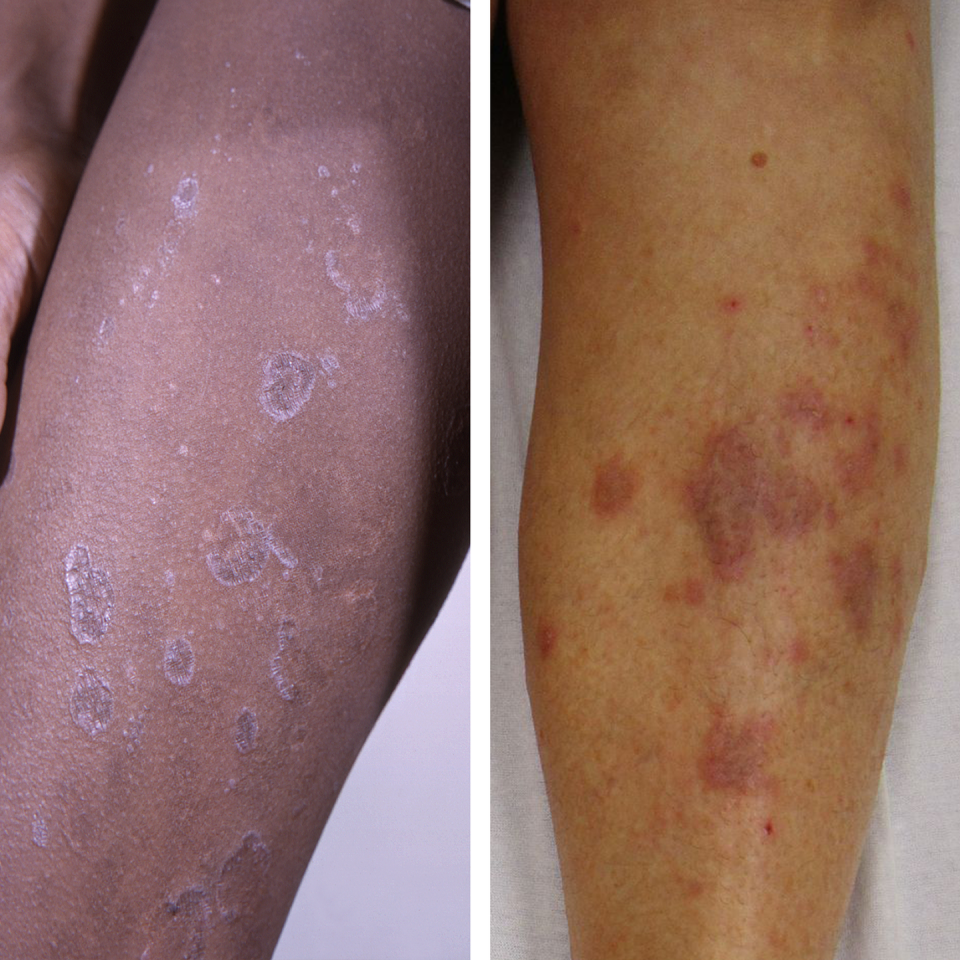
Measles
What it looks like: Measles causes flat, red spots that cover huge swaths of skin. The rash often appears on the face near the hairline, then spreads down to the feet.
Other symptoms to note: The rash is accompanied by flu-like symptoms, including high fever, cough, and runny nose. Conjunctivitis (pink eye) is also common. Young people could face severe complications from measles, so contact your healthcare provider if you suspect exposure to the illness. Measles is spread when an infected person coughs or sneezes, and it’s one of the most contagious diseases, per the CDC.
Treatment: There is no specific antiviral therapy for measles. but it's usually recommended that people with measles drink plenty of water and get lots of rest, Nemours says.
Top image credit: Mike Blyth

Hand, foot, and mouth disease
What it looks like: Hand, foot, and mouth disease is named for its characteristic flat, red spots that appear on the palms, soles of the feet, and around the mouth.
Other symptoms to note: Spots may blister over time. Cold-like symptoms, including fever and loss of appetite, might also appear. It’s usually not serious, but it’s very contagious and can spread quickly through skin contact or respiratory transmission among people of any age, especially in schools.
Treatment: There is no specific treatment for hand, foot, and mouth disease but the CDC says that taking over-the-counter medications like acetaminophen or ibuprofen can help to relieve fever and pain.
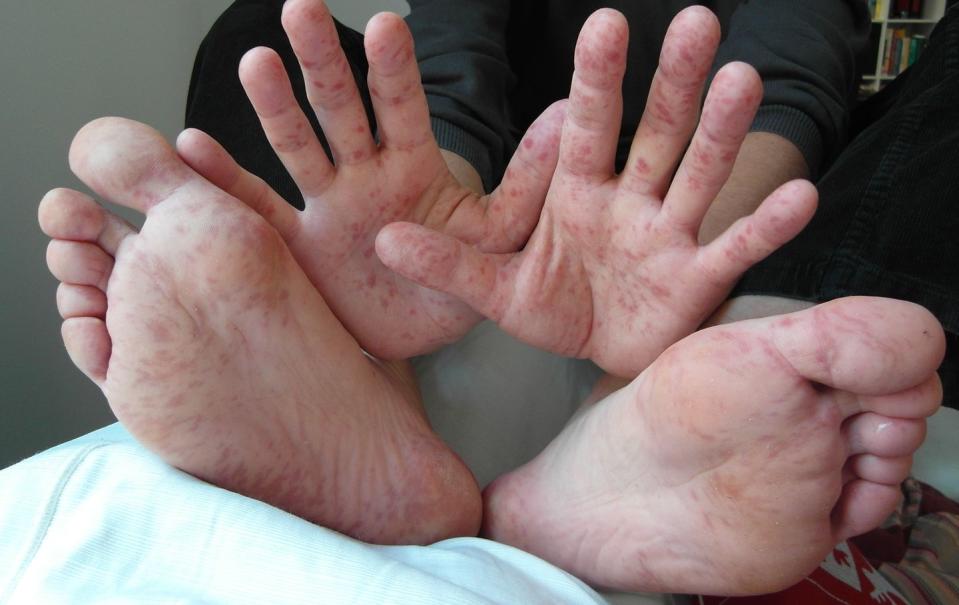
Tick bite
What it looks like: The most recognizable reaction on this list is the bullseye rash—a large, red, target-like rash that signals the early stages of Lyme disease from the bite of an infected blacklegged tick. However, many tick bites do not cause a bullseye rash; it appears in about 70 to 80% of Lyme patients.
Other symptoms to note: You might actually find a tick attached to you before a tick bite rash appears, which is usually itchy. If the tick is still attached, you have to be very careful when you remove the tick head. Once the rash appears, the bullseye rash in particular is a telltale sign of Lyme disease, even though some patients never get one.
Treatment: Once the tick is removed, you'll want to monitor your symptoms and let your doctor know as soon as you notice one. If you live in an area where Lyme disease is common, your doctor may recommend a single dose of the antibiotic doxycycline, the CDC says.
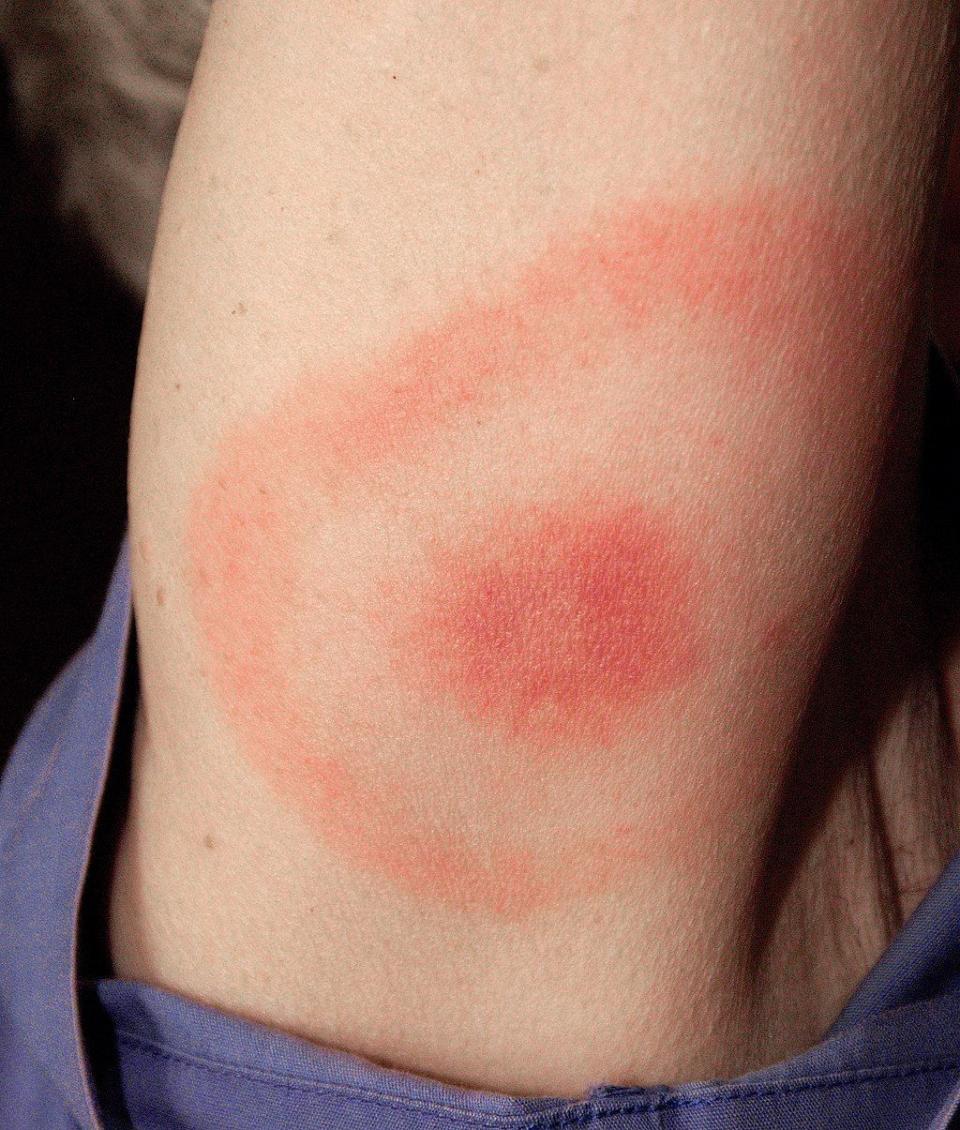
Lupus
What it looks like: Lupus, a chronic autoimmune disease that causes inflammation throughout the body, often presents with a red, butterfly-shaped rash across the cheeks and nose. It is usually worsened by exposure to the sun.
Other lupus symptoms to note: Although the rash does not leave scarring, it could cause discoloration after it disappears. The butterfly rash is distinct from the sores and scaly lesions also caused by lupus.
Treatment: Each case varies, but topical treatments and lifestyle changes can help the rash fade.
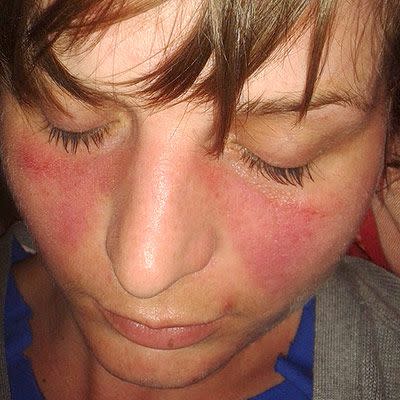
Petechiae
What it looks like: “Petechiae is essentially blood leakage into the skin,” explains Dr. Lal. It looks like small red blotches or tiny, red pinpoint marks on the skin. These marks can appear anywhere but typically appear in areas where there is more pressure, such as the back, palms, and soles of the feet.
Other symptoms to note: Petechiae is a symptom related to other illnesses (most commonly, meningitis or lupus). It happens because of inflammation in the skin and blood vessels, leading to blood leakage into the skin.
Treatment: Petechiae marks will go away with time while undergoing treatment for the root cause.
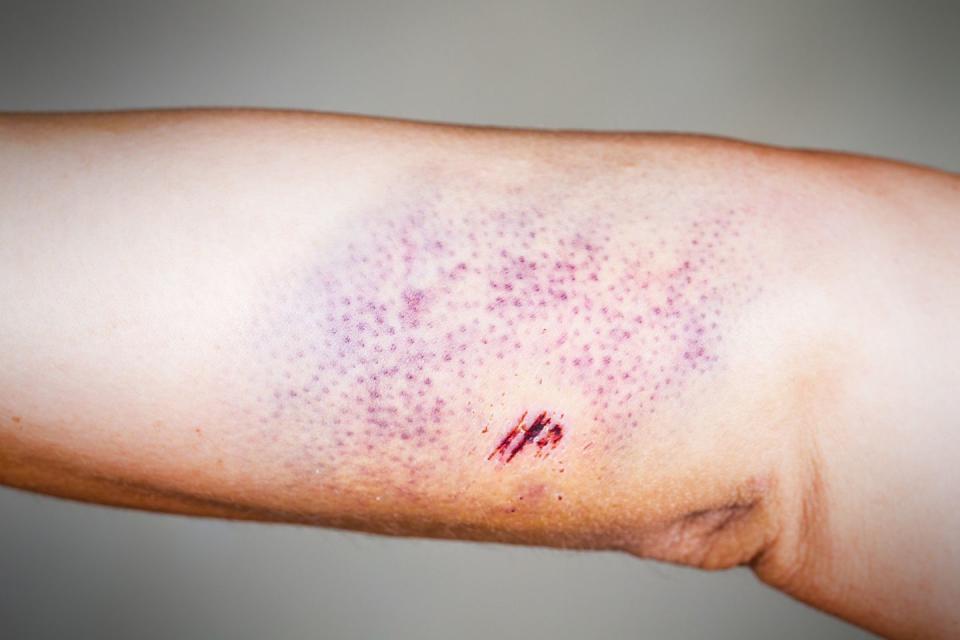
Warts
What it looks like: Skin colored, rough bumps that typically develop on the feet may be warts, explains Dr. Zeichner. “They usually have a rough surface, resembling cauliflower. In some cases, there may be an individual spot or you may have multiple.” He adds that besides the feet, warts commonly develop on the hands, knees, or almost anywhere on the body.
Other symptoms to note: They are generally considered to be harmless, except for their cosmetic appearance. However, in some cases, they may be uncomfortable, especially when they develop on the bottom of the feet, says Dr. Zeichner.
Treatment: “Warts can be treated with over-the-counter products that contain salicylic acid, [which] helps exfoliate dead cells that are infected by the virus. They also can be frozen with over-the-counter wart sprays, which kill the cells that are infected by the virus," Dr. Zeichner says. If warts are not improving after a month of at-home treatments, visit a dermatologist for professional help. According to Dr. Zeichner, your dermatologist can freeze the warts with professional strength liquid nitrogen or use a variety of other prescription options, both topically or injected.
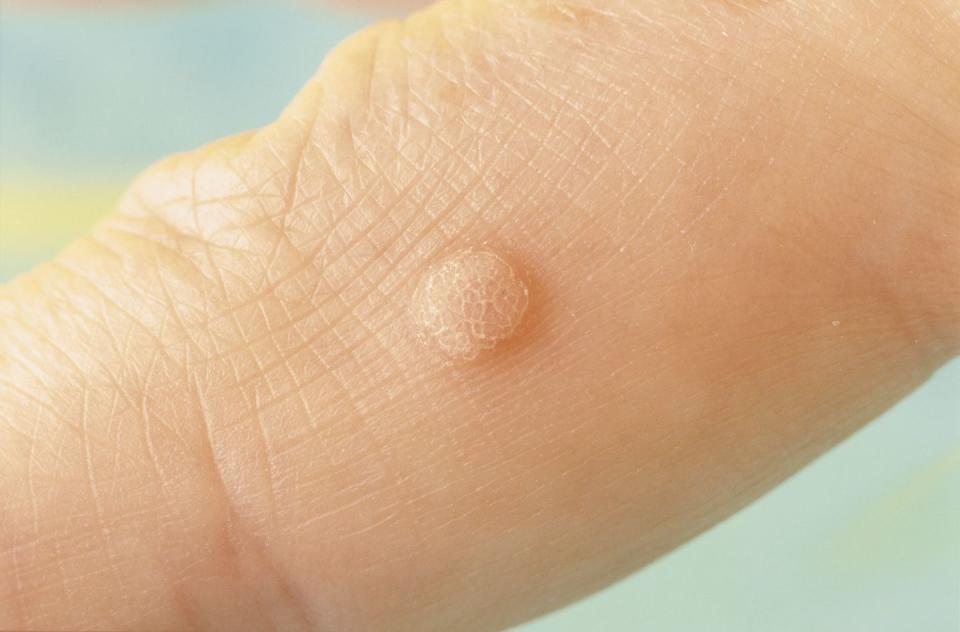
Athlete’s foot
What it looks like: Athlete’s foot is a rash caused by a fungal infection of the skin. People typically develop a rash between the toes, and the skin becomes white, moist, and falls apart, explains Dr. Zeichner. “In some cases, it can affect the entire bottom of the feet in the distribution of a moccasin shoe. Here, the entire bottom of the feet becomes rough and scaly.”
Other symptoms to note: “In some cases,” says Dr. Zeichner, “it can affect the entire bottom of the feet in the distribution of a moccasin shoe. Here, the entire bottom of the feet becomes rough and scaly.”
Treatment: Athlete’s foot can be treated with over-the-counter antifungal creams. If twice daily use after 2 to 4 weeks is not helping, Dr. Zeichner suggests that you visit your dermatologist for prescription topical or oral medications.

Molluscum
What it looks like: Molluscum is a rash where small groups of bumps develop on the skin, says Dr. Zeichner. “The bumps have a pearly appearance, and usually have a central indentation.”
Other symptoms to note: Molluscum is caused by a virus and is spread by direct contact. Dr. Zeichner says that it is “common in children and in people with a disrupted skin barrier, such as eczema.” It also can spread through intimate contact and is seen in the genital areas in adults.
Treatment: The bumps go away on their own over several months. However, they are contagious, even to other parts of your own body, so Dr. Zeichner recommends getting professional treatment. Your dermatologist can scrape them, freeze them, or give you topical treatments to help get rid of them.
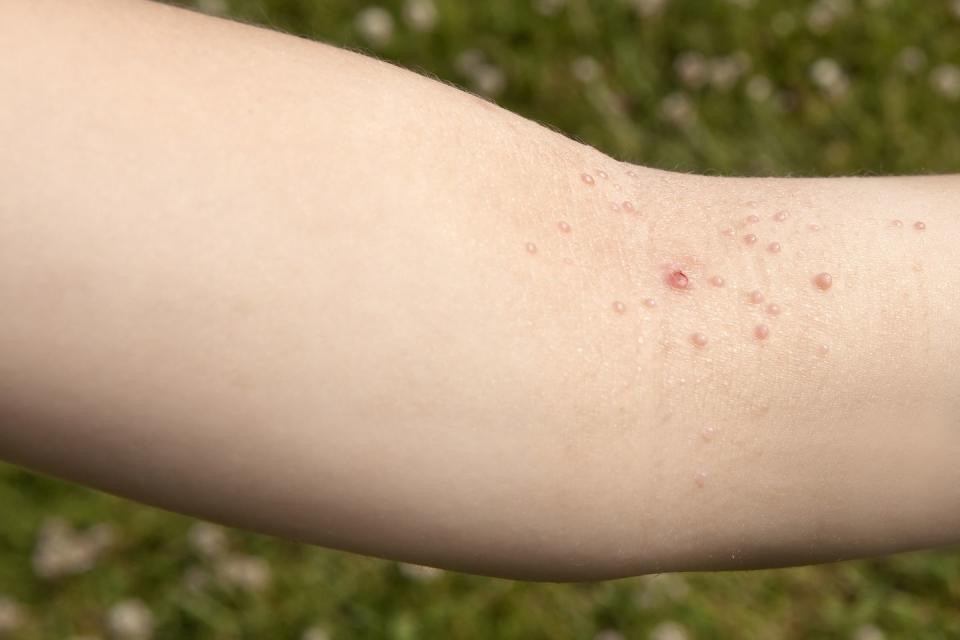
Pityriasis rosea
What it looks like: Pityriasis rosea is a rash where oblong, red scaly patches develop typically on the chest in the back, says Dr. Zeichner. “The rash develops in streaks and is thought to resemble a Christmas tree pattern.”
Other symptoms to note: It is unclear why the rash develops, but it is thought to be an immune response after an upper respiratory infection, says Dr. Zeichner. “Proper diagnosis is important for management.”
Treatment: Fortunately, no matter what you do to treat your pityriasis rosea, the rash is self-resolving and goes away on its own after about eight weeks.
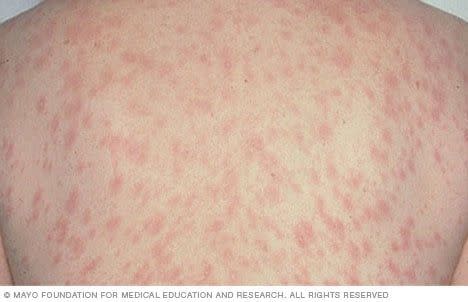
Actinic keratoses
What it looks like: Actinic keratoses are pre-cancerous changes to the skin caused by sun damage, explains Dr. Zeichner. “The rash feels like sandpaper when you run your fingers over it.” In some cases, there may be significant scaling in individual areas.
Other symptoms to note: Actinic keratosis typically develops on sun-exposed areas like the face and the arms. It is important to see a dermatologist if you have this condition because the spots are at risk for turning into skin cancers in the future, says Dr. Zeichner.
Treatment: “Your dermatologist may freeze them with liquid nitrogen, apply other topical treatments or lasers, or give you a prescription for a cream to use at home," Dr. Zeichner says.
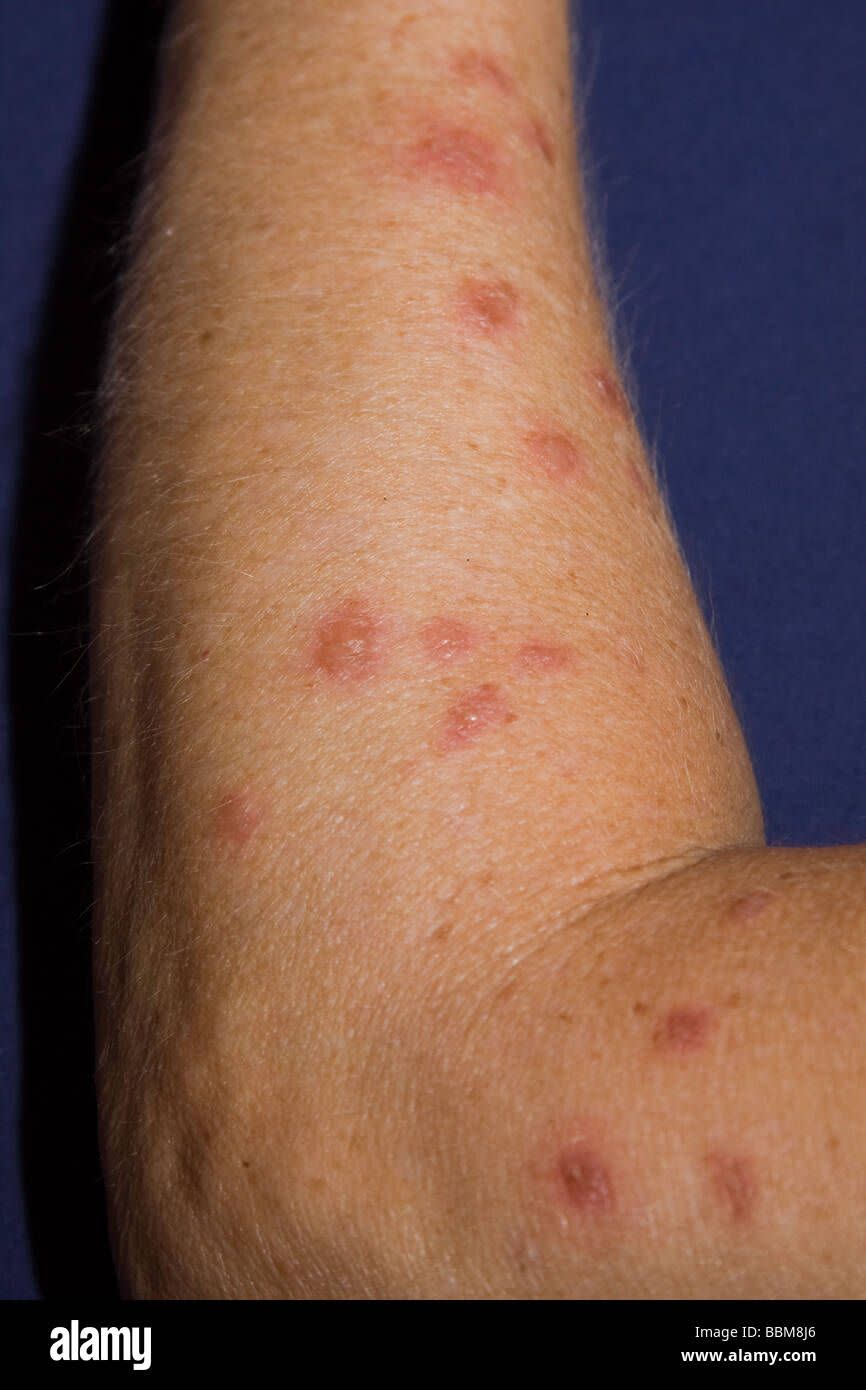
Flea bites
What it looks like: Flea bites appear most often on the feet, ankles, and lower legs, per the Cleveland Clinic. After a flea bites you, a small, discolored bump forms and a discolored ring or halo may appear around the bite.
Other symptoms to note: Flea bites may appear in a straight line or a cluster of many bites
Treatment: To treat the bites, first wash the lesions with an antibacterial soap. Then, use a skin soothing treatment like calamine lotion to combat the irritation, per the Cleveland Clinic. OTC anti-itch creams or ointments, along with antihistamines can relieve itchy skin and discomfort, the organization says.
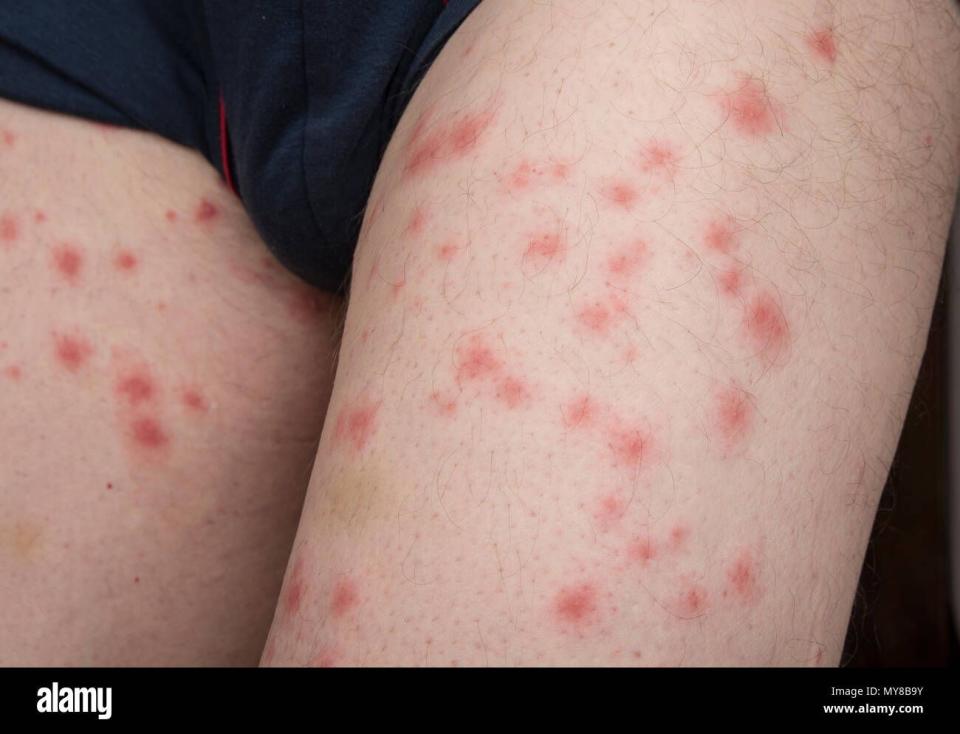
Fifth disease
What it looks like: Fifth Disease is caused by Parvovirus B19 and presents with a red rash on the cheeks, arms, and legs that can last for several weeks. This condition occurs most often in children.
Other symptoms to note: In addition to the signature slapped cheek look of Fifth Disease, other symptoms include nausea, sore throat, headache, and a low-grade fever.
Treatment: Generally, there is no treatment necessary, as the rash will go away on its own. However, its symptoms can be managed with over-the-counter medication like acetaminophen, Mount Sinai says.
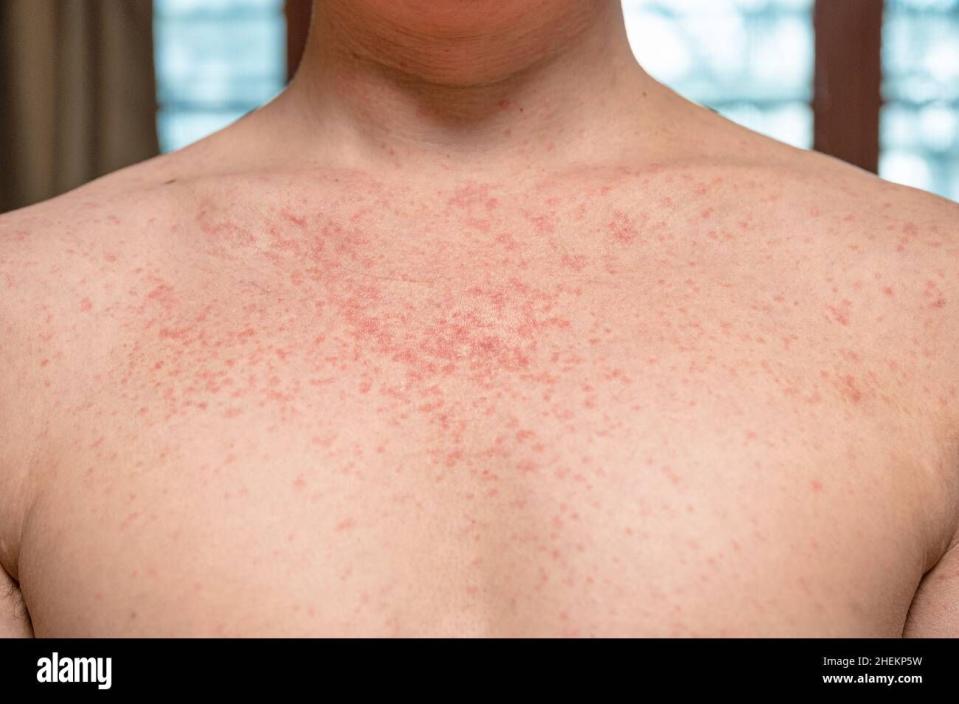
Impetigo
What it looks like: Impetigo occurs most often on the face, particularly around the nose and mouth. This contagious skin rash is caused by streptococcus and staphylococcus bacteria that enter the body through compromised skin.
Other symptoms to note: Initially, red blisters form at the infection site. After they swell and burst, a honey-colored crust forms.
Treatment: If you suspect you have impetigo, pay a visit to your primary healthcare provider. They may prescribe topical or oral antibiotics, per the CDC.
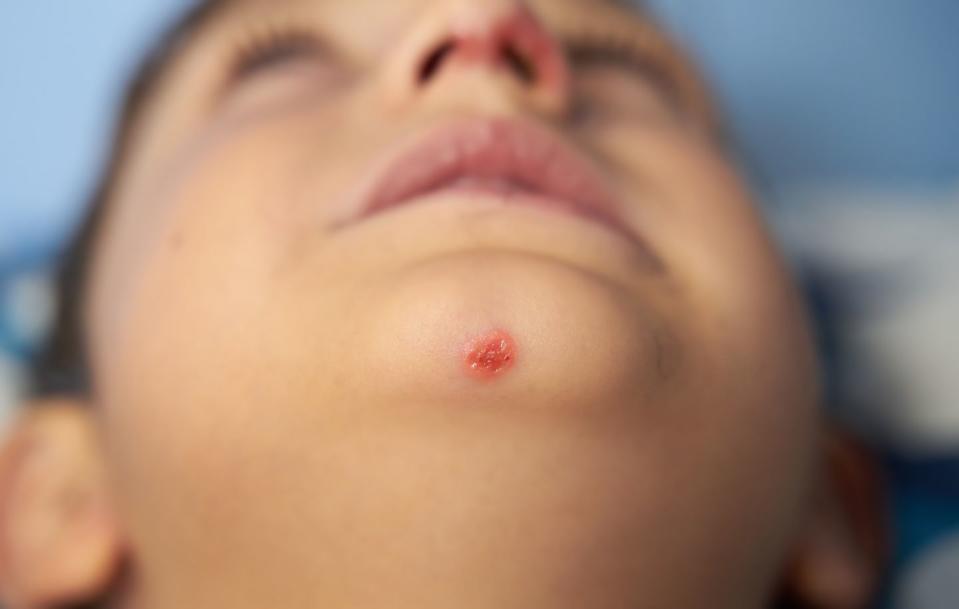
Scarlet fever
What it looks like: Scarlatina, a.k.a. scarlet fever, occurs from the Group A streptococcus bacteria of a strep throat infection, per the CDC. The bacteria releases a toxin that causes a bright red blotchy rash that has a sandpaper-like texture, and the rash can spread to the entire body and usually first appears on the groin, neck, and underarms.
Other symptoms to note: Other symptoms of scarlet fever include a high fever and sore throat.
Treatment: If you suspect that you have scarlet fever, you'll want to contact your doctor. The CDC says they'll likely recommend that you take antibiotics.
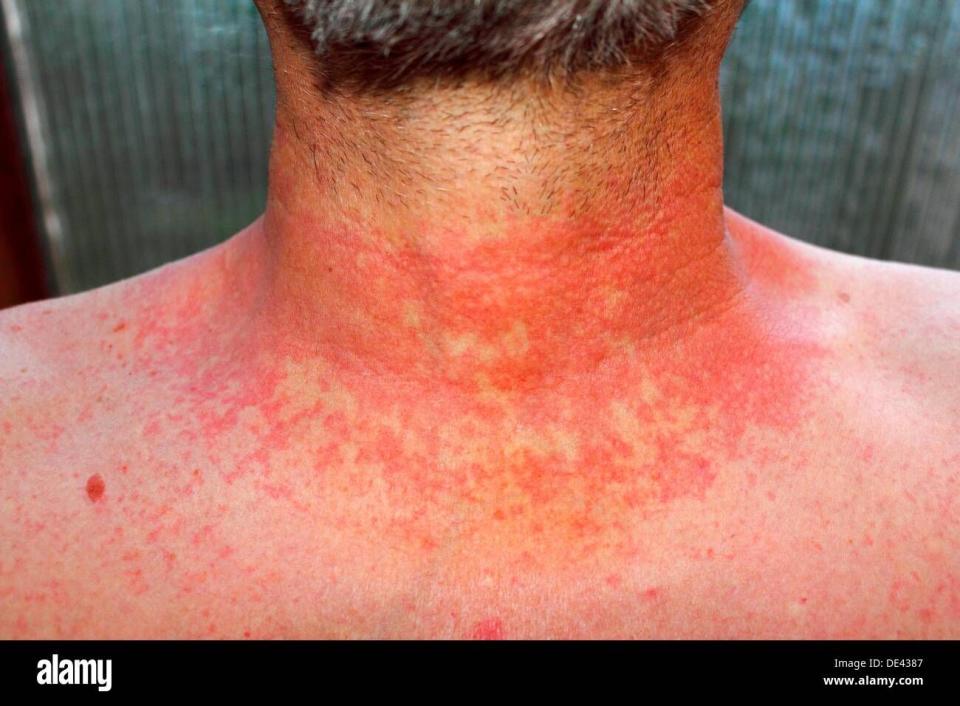
How to identify common skin rashes and their symptoms
Size and location are the first things to consider when trying to identify a rash. “Something that’s localized with distinct borders will typically be an outside-in job,” Dr. Zeichner says, while inside-out ones “can lead to red, angry rashes throughout the entire body.” The next clues to look for are the shape, color, and texture of the rash.
“If your over-the-counter products aren’t working, you’re suffering from a rash for a week or so, and it’s not improving, you should touch base with a board-certified dermatologist,” Dr. Zeichner says. “This is what we are trained to do, and treatment depends on proper diagnosis.” Be sure to tell your doctor how long you’ve had the rash and any other symptoms you’ve been experiencing (such as a fever or difficulty breathing).

When to see your doctor for a skin rash
While some skin rashes will go away on their own and can be managed at home, there are a few key signs you shouldn’t ignore and head to your doctor, or even in some cases, the emergency room.
If you are in pain, your rash is itchy enough to interfere with your daily activities, or you observe the rash spreading, a visit to your dermatologist is likely warranted. “Essentially, if you cannot manage it at home within five to seven days, it’s time to see your dermatologist,” says Dr. Lal.
However, if you have any signs of systemic illness, Dr. Lal urges you to go to the emergency room. These signs include: Fever, chills, neck pain, fatigue, inability to look at bright light, or inability to eat or drink. “If you have those symptoms, it’s time to go to the emergency room. This is not the time to go to the dermatologist,” explains Dr. Lal.

You Might Also Like

